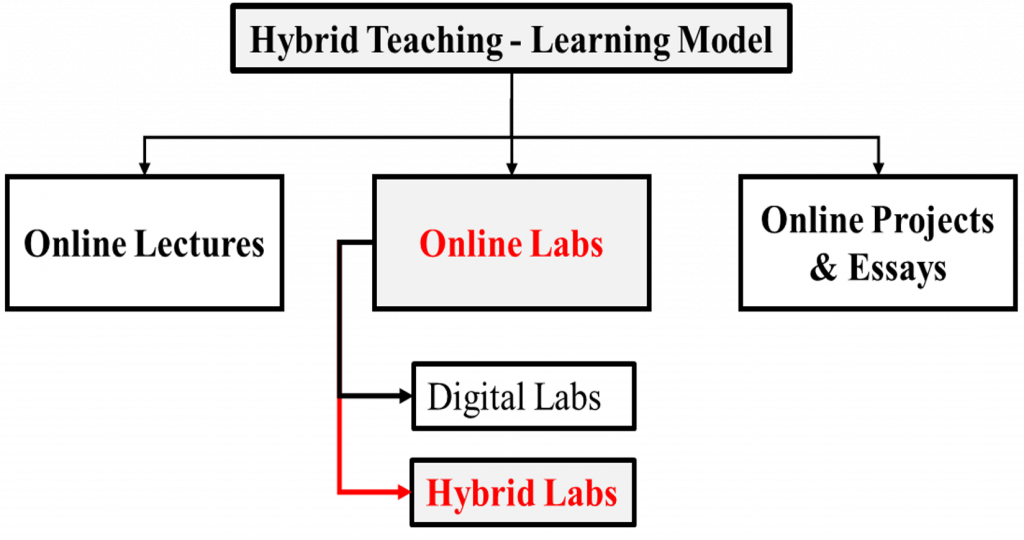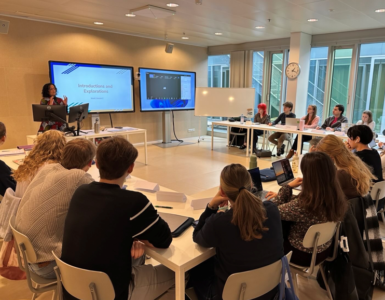by Dimitris Mourtzis, University of Patras, Greece.
The Coronavirus pandemic (SARS CoV-2) has expanded the gaps in the education sector globally. The outbreak of COVID-19 has created educational disruptions and global health concerns, which have proved very difficult to manage through global health systems. The lockdowns forced both educators and students to swiftly rely on digital technologies in order to ensure the successful completion of modules based on the official curriculum.1 This unprecedented disruption has brought new challenges for educators as learning in many institutes has transitioned from in-person instruction to distance learning models that include combinations of in-person instruction and virtual learning. The Online Learning Spectrum is illustrated in Figure 1.

I would like to mention that Hybrid learning combines face-to-face and online teaching into one cohesive experience. I have summarized the benefits of the Hybrid Teaching/Learning Model as follows2:
- Sustaining group cohesion, collaboration, and support
- Reflective, on-task discourse
- Broader participation in discussions
- Critical analysis
- Self-paced learning and practice
- Self-assessment quizzes with feedback
- Automatic grading of multiple choice, True/False, fill-in-the-blank tests
- Create a content outline, divide content into modules
Hybrid Teaching at-a-glance
Hybrid Teaching may involve synchronous and asynchronous learning activities.
In Synchronous Learning students learn together in real time participating in lectures, tutorials, lab sessions, etc. conducted face-to-face or online. On the other hand, in Asynchronous Learning: students learn in their own time and not in the same place through interactions with peers, educators or content in their own time via pre-recorded videos online, discussion forums, collaborative activities, etc.3
Teaching Factory Model towards Education 4.0
Teaching Factory Model is defined as a “two-way knowledge communication channel”, where from the factory, practitioners teach students and from the classroom, students and faculty teach practitioners. This two-way street is realized via internet and is a continuous process over a lengthier period, with regular sessions and continuous interaction between the factory and the classroom.4-7 The Teaching Factory is a University-Industry partnership in which students participate in industrial projects for clients and industrial sponsors interact with students and faculty to contribute towards developing world-class engineers with the required skills of the era.8
Why Hybrid Model?
Universities are facing the challenging issue of how to offer high quality learning opportunities without risking participants` health.
Proposed Solution
A Hybrid Teaching-Learning Model (HTLM) under the Teaching Factory framework concept that has been successfully implemented and validated towards Education-as-a-Personalized-Service Model as illustrated in Figure 2.
A set of services is offered through the Cloud Collaborative Platform9:
- Virtual Reality (VR) applications
- Augmented Reality (AR) applications to visualize the final design
- A similarity tool to compare CAD Files

The applicability of the proposed framework has been validated in a case study in our laboratory machine-shop. The HTLM model structure is presented in Figure 3. I would also like to mention that the proposed model was based on hybrid labs that referred to the digitalization of laboratory operations and to the digitization of the data processes to enable continuous workflows and improve the quality of the laboratory. The TF pilot involved a “real-life” engineering challenge to be elaborated by engineering students under the supervision of University Professors and technicians. Twelve teams were formed, each consisting of 20 student engineers. Each team developed its own process planning, scheduling, and simulation process during the Semester via Hybrid Laboratories and via the Collaborative Platform provided by the LMS Laboratory. The real-time assembly was streamed in a Skype for Business meeting channel. Finally, through the combination of ICT technologies, each team was able to guide the machine-shop technicians to assemble the final product in less than two (2) hours, in comparison to the real-life assembly labs in previous years, that each team needed almost three (3) hours to finalize the assembly.

Digital manufacturing technologies are an imperative set of support tools in a continuous effort to reduce the time and cost of product development as well as to expand the options for customization of the product, this shift towards the new digital hybrid model is a great opportunity for the users (i.e., students, professors, researchers etc.) to rapidly develop their soft skills.
The current situation forces educational authorities to provide formal e-education, which is a very challenging task, especially in developing countries where a suitable digital infrastructure in education is not widespread. Apart from the cost of accessing online education, several other considerations, such as network problems, inadequate power supply, disruptions, lack of digital soft skills, inaccessibility, and security concerns, may also obstruct a smooth “home learning” model. Nevertheless, I believe that challenges raised by COVID-19 could be transformed into an opportunity for learners to advance their problem-solving skills and their digital capabilities. This opportunity during the pandemic led to the rise of collaborative e-learning platforms, promoted public-private partnerships and developed soft skills, such as flexibility, adaptability, and responsibility. The proposed application allows the use of different platforms to facilitate implementation in any industrial environment at a low cost.

Author
Professor Dimitris Mourtzis, CIRP Fellow, IFAC, IFIP, SME, ASME, Vice-President Research and Development of University of Patras, Director: Laboratory for Manufacturing Systems and Automation (LMS), Department of Mechanical Engineering and Aeronautics, University of Patras
References
[1] Mourtzis, D., Panopoulos, N., Angelopoulos, J., Zygomalas, S., Dimitrakopoulos, G., & Stavropoulos, P. (2021). A Hybrid Teaching Factory Model for Supporting the Educational Process in COVID-19 era. Procedia Cirp, 104, 1626-1631. DOI: https://doi.org/10.1016/j.procir.2021.11.2742 Friend, C. (2021). Introduction to Hybrid Teaching: People, Pedagogy, Politics. Available at: https://www.codlearningtech.org/PDF/hybridteachingworkbook.pdf
3 Watts, L. (2016). Synchronous and asynchronous communication in distance learning: A review of the literature. Quarterly Review of Distance Education, 17(1), 23.
4 Chryssolouris G., Mavrikios D., Rentzos L. The Teaching Factory: A Manufacturing Education Paradigm. Procedia CIRP 2016;57:44-48. DOI: https://doi.org/10.1016/j.procir.2016.11.009.
5 Mourtzis D. Development of Skills and Competences in Manufacturing towards Education 4.0: A Teaching Factory approach 2018:194-210. DOI: http://dx.doi.org/10.1007/978-3-319-89563-5_15.
6 D. Mourtzis, Zogopoulos V., Vlachou E. Augmented Reality supported Product Design towards Industry 4.0: a Teaching Factory paradigm. Procedia Manufacturing 2018; 23: 207-212. DOI: https://doi.org/10.1016/j.promfg.2018.04.018.
7 Mavrikios D., Georgoulias K., Chryssolouris G. The Teaching Factory Network: A new collaborative paradigm for manufacturing education. Procedia Manufacturing 2019;31:398-403. DOI: https://doi.org/10.1016/j.promfg.2019.03.062.
8 Whiting, K. (2020, October). These are the top 10 job skills of tomorrow–and how long it takes to learn them. In World Economic Forum (Vol. 21).
9 Mourtzis, D., Siatras, V., Angelopoulos, J., & Panopoulos, N. (2020). An augmented reality collaborative product design cloud-based platform in the context of learning factory. Procedia Manufacturing, 45, 546-551. DOI: https://doi.org/10.1016/j.promfg.2020.04.076.














